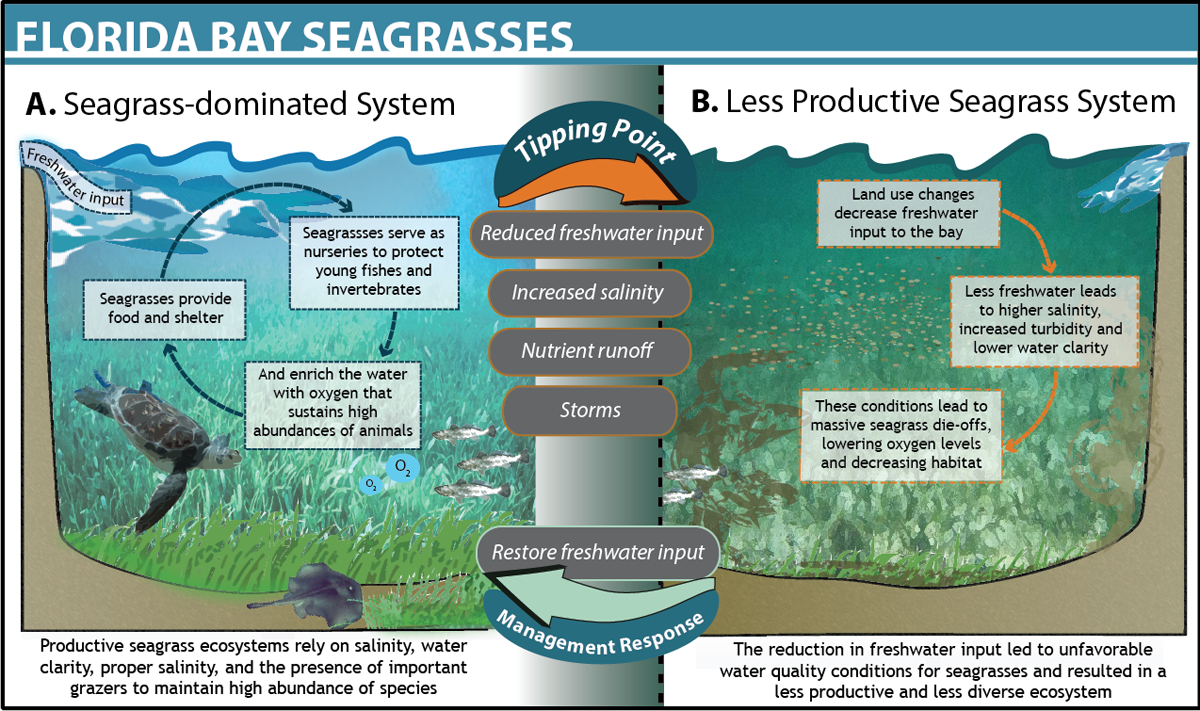Mismanagement of Florida Bay's fresh water supply led to a mass die-off of seagrass and loss of habitat for commerical fisheries in the region
The saga of seagrass in Florida Bay
Florida Bay is home to vast stretches of highly diverse and productive seagrass beds, serving as nursery grounds for juvenile fish and food and habitat for hundreds of marine species. This industrious habitat has had a storied history in the past few decades as land use change has altered water and nutrient delivery and salt levels.1
In the 1980s, changes in upstream land uses, such as agriculture, critically lowered the amount of fresh water supplied to the bay. Less fresh water led to increased concentrations of salt and decreased water circulation. The interaction of these factors led to a mass die-off of seagrass, affecting 30% of the entire seagrass community, lowering oxygen in the water, and resulting in a nonlinear shift between clear water and turbid water in some areas.2 The sources and symptoms of the die-off also led to the loss of key grazers, such as sea turtles, further exacerbating food chain impacts.
How Managers Tackled the Problem
The South Florida Water Management District (SFWMD) launched the first restoration and monitoring efforts in 1992. However, competing scientific hypotheses3 for the mechanisms of seagrass die-off hindered the SFWMD’s ability to control a single driver that would prevent further ecosystem change.1 After years of experimenting with various potential drivers, the SFWMD created the Minimum Flows and Levels program to maintain freshwater delivery and restore the seagrass ecosystems of the bay.4 If a minimum threshold of freshwater input is breached, upstream municipal and agricultural water uses are prohibited until water delivery is restored. There have been no seagrass die-offs since the implementation of this program.
What We Can Learn
Florida Bay was one of the 51 case studies of management in threshold-based ecosystems we quantitatively reviewed.5 Our findings suggest that threshold management works, routine monitoring is key, and geographic scale matters. In Florida Bay, the threshold of concern (freshwater input into the bay) is explicitly incorporated into management targets based on the best available science,6 monitoring occurs on a weekly basis to ensure the ecosystem variable is tracked on a time scale relevant to potential impacts if the threshold is crossed, and the spatial scale of upstream inputs is small enough for the SFWMD to manage and control their delivery.
Moreover, the SFWMD requires a five-year review of the Minimum Flow rule; uses indicators such as seagrass distribution, cover, and species composition to evaluate seagrass health; and works collaboratively with relevant regional managers under a legal mandate6 to ensure direct management of the primary stressor.2 However, it is important to note that there were significant challenges in understanding the appropriate management action to mitigate ecosystem degradation in Florida Bay.2 Socio-ecological systems are complex and it can be immensely difficult to isolate the key driver or drivers that are responsible for the tipping point and that can be managed.2
Florida Bay illustrates how managers can employ threshold-based targets and routine monitoring, among other tools, to mitigate rapid ecosystem degradation.
As the Ocean Tipping Points team has come to understand, the most successful scenarios for resource management occur when management is threshold-based, populations are monitored routinely, and the geographic scale for management is relatively small.
Learn more about our Management Review research and Ocean Tipping Points project.






